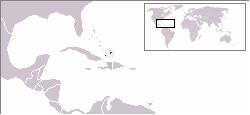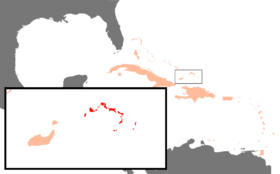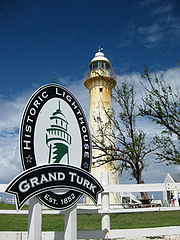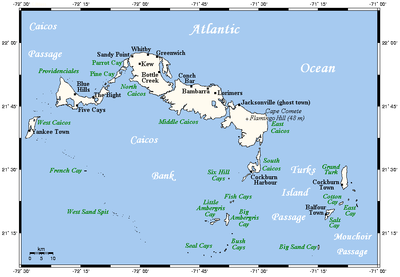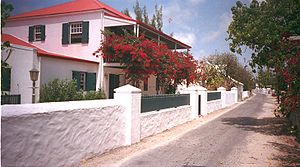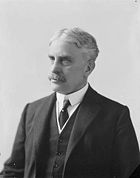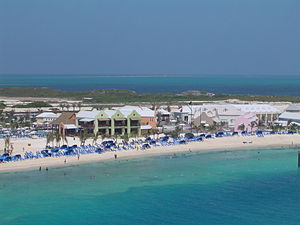
Turks and Caicos Islands
Did you know...
The articles in this Schools selection have been arranged by curriculum topic thanks to SOS Children volunteers. Child sponsorship helps children one by one http://www.sponsor-a-child.org.uk/.
| Turks and Caicos Islands | ||||||
|---|---|---|---|---|---|---|
|
||||||
| Motto: Beautiful By Nature, Clean By Choice | ||||||
| Anthem: " God Save the Queen" National Song: "We Salute this Land of Ours" |
||||||
|
|
||||||
|
|
||||||
| Capital | Cockburn Town | |||||
| Largest city | Providenciales | |||||
| Official languages | English | |||||
| Ethnic groups | Black 90%, Mixed, European, or North American 10% | |||||
| Demonym | Turks and Caicos Islander | |||||
| Government | British overseas territory (self-government currently suspended) | |||||
| - | Queen | Elizabeth II | ||||
| - | Governor | Gordon Wetherell | ||||
| - | Premier | office suspended | ||||
| Area | ||||||
| - | Total | 430 km2 ( 199th) 193 sq mi |
||||
| - | Water (%) | negligible | ||||
| Population | ||||||
| - | 2009 estimate | 36,605 ( ?) | ||||
| - | Density | 88/km2 ( n/a) 135/sq mi |
||||
| HDI (n/a) | 0.930 very high · n/a |
|||||
| Currency | U.S. dollar ( USD) |
|||||
| Time zone | UTC-5 | |||||
| - | Summer ( DST) | UTC-4 ( UTC) | ||||
| Date format | d/m/yy (AD) | |||||
| Drives on the | left | |||||
| Calling code | +1-649 | |||||
| ISO 3166 code | TC | |||||
| Internet TLD | .tc | |||||
Coordinates: 21.505°N 71.754°W The Turks and Caicos Islands (pronounced /ˈtɜrks/ and /ˈkeɪkəs/ or /ˈkeɪkoʊs/; abbreviated TCI) are a British Overseas Territory consisting of two groups of tropical islands in the West Indies, the larger Caicos Islands and the smaller Turks Islands, known for tourism and as an offshore financial centre.
The Turks and Caicos Islands lie southeast of Mayaguana in the Bahamas and north of the island of Hispaniola. Cockburn Town, the capital, is situated about 1,042 kilometres (647 mi) east-southeast of Miami in the United States. The islands have a total land area of 430 square kilometres (170 sq mi). The islands are geographically contiguous to the Bahamas, but are politically a separate entity.
The total population is about 36,000, of whom approximately 22,500 live on Providenciales in the Caicos Islands. Cockburn Town, the capital, is on Grand Turk Island.
In August 2009, the United Kingdom suspended the Turks and Caicos' self-government after allegations of ministerial corruption. The prerogative of the ministerial government and the House of Assembly are vested in the islands' incumbent governor, Gordon Wetherell, for a period of up to two years.
History
The Turks and Caicos Islands are named after the indigenous Turk's Head "fez" cactus (Melocactus communis), and the Lucayan term "caya hico", meaning string of islands. The first inhabitants of the islands were Arawakan-speaking Taíno people who crossed over from Hispaniola sometime from 500 to 800. Together with Tainos who crossed over from Cuba to the southern Bahamas around the same time, these people became the Lucayans. Around 1200 the Turks and Caicos Islands were resettled by Classical Taínos from Hispaniola. Soon after they arrived in the islands in 1492, the Spanish began capturing the Taínos of the Turks and Caicos Islands and the Lucayans as slaves to replace the largely depleted native population of Hispaniola. The southern Bahama Islands, including the Turks and Caicos Islands, were completely depopulated by about 1513, and remained so until the 17th century.
The first documented European to sight the islands was Spanish conquistador Juan Ponce de León, who did so in 1512. During the 16th, 17th and 18th centuries, the islands passed from Spanish, to French, to British control, but none of the three powers ever established any settlements.
For several decades around the turn of the 18th century they became popular pirate hideouts. Bermudian salt collectors settled the Turk Islands around 1680. In 1765–1783 they were under French occupation and again after the French captured the archipelago in 1783. After the American Revolution (1775–1783) many loyalists fled to Caribbean colonies, including (in 1783) the first settlers on the Caicos Islands; cotton became an important crop briefly. In 1799, both the Turks and the Caicos island groups were annexed by Britain as part of the Bahamas.
In 1841 the Trouvadore, a Spanish ship engaged in the slave trade, wrecked off the coast of East Caicos, one of the larger Caicos Islands. One hundred and ninety-two captive Africans survived the sinking and made it to shore where, under British rule, the slave trade was illegal. These survivors were apprenticed to trades for one year then settled mostly on Grand Turk Island. An 1878 letter documents the "Trouvadore Africans" and their descendants as constituting an essential part of the "labouring population" on the islands. In 2004 marine archaeologists rediscovered a wreck, called the "Black Rock Ship", that subsequent research has suggested may be that of the Trouvadore. This suggestion was further supported when a marine archaeology expedition funded by NOAA in November 2008 confirmed that the wreck comprises artifacts of which the style and date of manufacture support the association of this wreck with that of the Trouvadore. The wreckage has, however, not been identified with absolute certainty.
In 1848, the Turks and Caicos were declared a separate colony under a council president. The last incumbent was maintained in 1873 when the islands were made part of Jamaica colony; in 1894 the chief colonial official was restyled commissioner. In 1917, Canadian Prime Minister Robert Borden suggested that the Turks and Caicos join Canada, but this suggestion was rejected by British Prime Minister David Lloyd George. The islands remained a dependency of Jamaica until 1959.
On 4 July 1959, the islands were again a separate colony, the last commissioner being restyled administrator, but the governor of Jamaica remained the governor of the islands. Until 31 May 1962, they were one of the constitutive parts of the Federation of the West Indies.
When Jamaica was granted independence from Britain in August 1962, the Turks & Caicos Islands became a crown colony. From 1965, the governor of the Bahamas was also governor of the Turks and Caicos Islands and oversaw affairs for the islands. When the Bahamas gained independence in 1973, the Turks and Caicos received their own governor (the last administrator was restyled). In 1974, Canadian New Democratic Party MP Max Saltsman tried to use his Private Member's Bill to create legislation to annex the islands to Canada, but it did not pass in the Canadian House of Commons.
The islands have had their own government headed by a chief minister, the first of whom was James Alexander George Smith McCartney, since August 1976. In 1979, a move towards independence was agreed upon in principle for 1982, but a change in government caused a policy reversal, and they instead approached the Canadian government to discuss a possible union, but at the time the Canadian Government was embroiled in a debate over free trade with the U.S., and little attention was paid to the suggestion. In 2004 the Canadian province of Nova Scotia gave an invitation to join but Canada's government said they would look at the matter later. The islands' political troubles in recent years have resulted in a rewritten constitution promulgated in 2006 and a reintroduction of direct UK Government rule in 2009.
Geography
The two island groups are in the North Atlantic Ocean, southeast of the Bahamas, north of Hispaniola, and about 1,000 kilometres (620 mi) from Miami in the United States, at 21°45′N 71°35′W. The territory is geographically contiguous to the Bahamas, both comprising the Lucayan Archipelago, but is politically a separate entity. The Caicos Islands are separated by the Caicos Passage from the closest Bahamian islands, Mayaguana and Great Inagua.
The eight main islands and more than 299 smaller islands have a total land area of 616.3 square kilometres (238.0 sq mi), primarily of low, flat limestone with extensive marshes and mangrove swamps and 332 square kilometres (128 sq mi) of beach front. The weather is usually sunny and relatively dry, but suffers frequent hurricanes. The islands have limited natural fresh water resources; private cisterns collect rainwater for drinking. The primary natural resources are spiny lobster, conch and other shellfish.
The two distinct island groups are separated by the Turks Passage.
Turks Islands
The Turks Islands are separated from the Caicos Islands by Turks Island Passage which is more than 2,200 m/7,200 ft deep), The islands form a chain that stretches north–south. The estimated population is 5,753 on the two main islands, the only inhabited islands of the group:
- Grand Turk (with the capital of the territory, area 17.39 km2 (6.71 sq mi), population 5,567)
- Salt Cay (area 6.74 km2 (2.60 sq mi), population 186)
Together with nearby islands, all on Turks Bank, those two main islands form the two of the six administrative districts of the territory that fall within the Turks Islands. Turks Bank, which is smaller than Caicos Bank, has a total area of about 324 km2 (125 sq mi).
Mouchoir Bank
25 kilometres (16 mi) east of the Turks Islands and separated from them by Mouchoir Passage is the Mouchoir Bank. Although it has no emergent cays or islets, some parts are very shallow and the water breaks on them. Mouchoir Bank is part of the Turks and Caicos Islands and falls within its Exclusive Economic Zone. It measures 960 square kilometres (370 sq mi) in area. Two banks further east, Silver Bank and Navidad Bank, are geographically a continuation, but belong politically to the Dominican Republic.
Administrative divisions
The Turks and Caicos Islands are divided into six administrative districts (two in the Turks Islands and four in the Caicos Islands), headed by district commissioners. For the House of Assembly, the Turks and Caicos Islands are divided into 15 electoral districts (four in the Turks Islands and eleven in the Caicos Islands).
Climate
Turks and Caicos Islands features a tropical monsoon climate with relatively consistent temperatures throughout the course of the year. Summertime temperatures rarely exceed 92 degrees Fahrenheit (33 degrees Celsius) and the winter months have daytime temperatures between 68 and 80 °F (20 and 27 °C), rarely falling below 50 °F (10 °C).
| Climate data for Turks and Caicos Islands | |||||||||||||
|---|---|---|---|---|---|---|---|---|---|---|---|---|---|
| Month | Jan | Feb | Mar | Apr | May | Jun | Jul | Aug | Sep | Oct | Nov | Dec | Year |
| Average high °C (°F) | 22 (71.6) |
23.2 (73.8) |
24.6 (76.3) |
26.5 (79.7) |
27.7 (81.9) |
29.5 (85.1) |
29.9 (85.8) |
28.3 (82.9) |
26.4 (79.5) |
24.8 (76.6) |
22.5 (72.5) |
21.5 (70.7) |
25.58 (78.04) |
| Average low °C (°F) | 16.8 (62.2) |
17 (62.6) |
19.9 (67.8) |
21.6 (70.9) |
23.1 (73.6) |
24.5 (76.1) |
25 (77) |
24.6 (76.3) |
22.8 (73) |
20.4 (68.7) |
17.9 (64.2) |
16.2 (61.2) |
20.82 (69.47) |
| Precipitation mm (inches) | 54.7 (2.154) |
51.7 (2.035) |
53.8 (2.118) |
52.4 (2.063) |
65.6 (2.583) |
92.9 (3.657) |
114.3 (4.5) |
155.5 (6.122) |
175.8 (6.921) |
109.1 (4.295) |
68.5 (2.697) |
56.9 (2.24) |
1051.2 (41.386) |
| Source: National Weather Service | |||||||||||||
Politics
The Turks and Caicos Islands are a British Overseas Territory, a possession of the United Kingdom currently ruled directly by a British-appointed governor. Its autonomous system of government was suspended in August 2009. The United Nations Committee on Decolonisation includes the territory on the United Nations list of Non-Self-Governing Territories.
With the election of the territory's first Chief Minister, J.A.G.S. McCartney, the islands adopted a constitution on 30 August 1976, which is Constitution Day, the national holiday. The constitution was suspended in 1986, but restored and revised 5 March 1988. A new constitution came into force on 9 August 2006, but was in parts suspended and amended in 2009. The territory's legal system is based on English common law, with a small number of laws adopted from Jamaica and the Bahamas. Suffrage is universal for those over 18 years of age. English is the official language. Grand Turk is the administrative and political capital of the Turks and Caicos Islands and Cockburn Town has been the seat of government since 1766.
As a British territory, Queen Elizabeth II of the United Kingdom is the sovereign, represented by a governor appointed by the monarch, on the advice of the Foreign Office.
Under the suspended constitution, the head of government was the premier, appointed by the governor. The cabinet consisted of three ex officio members and five appointed by the governor from among the members of the House of Assembly. The unicameral House of Assembly consisted of 21 seats, of which 15 are popularly elected; members serve four-year terms. Elections in the Turks and Caicos Islands were held on 24 April 2003 and again on 9 February 2007. The Progressive National Party, led by Galmo Williams, held thirteen seats, and the People's Democratic Movement, led by Floyd Seymour, held two seats.
The judicial branch of government is headed by a Supreme Court and appeals are heard by the court of appeals and final appeals by the Judicial Committee of the Privy Council of the United Kingdom. The Chief Justice of the Supreme Court was Gordon Ward. The islands also have a Court of Appeal with a President and at least two Justices of Appeal.
The Turks and Caicos Islands participates in the Caribbean Development Bank, is an associate in CARICOM, and maintains an Interpol sub-bureau. Defence is the responsibility of the United Kingdom. In December 2004, the islands sought to become a new associate member to the Association of Caribbean States.
Moves toward independence
The winning party of Turks and Caicos' first general election in 1976, the People’s Democratic Movement (PDM) under McCartney, sought to establish a framework and accompanying infrastructure in the pursuit of an eventual policy of full independence for the islands. However, with the early death of McCartney, confidence in the country’s leadership waned. In 1980, the PDM agreed with the British government that independence would be granted in 1982 if the PDM was reelected in the elections of that year. That election was effectively a referendum on the independence issue and was won by the pro-dependency Progressive National Party (PNP), which claimed victory again four years later. With these developments, the independence issue largely faded from the political scene.
However, in the mid-2000s, the issue of independence for the islands was again raised. In April 2006, PNP Premier Michael Misick reaffirmed that his party saw independence from Britain as the "ultimate goal" for the islands, but not at the present time.
In 2008, opponents of Misick accused him of moving toward independence for the islands in order to dodge a commission of inquiry, which examined reports of corruption by the Misick Administration.
Proposed union with Canada
A great number of tourists who visit the Turks and Caicos Islands are Canadian. Owing to this, the islands' status as a British colony, and historic trade links, some politicians in Canada and the Turks and Caicos have suggested some form of union between Canada and the British territory.
In 1917, the Prime Minister of Canada, Robert Borden first suggested that Canada annex the Turks and Caicos Islands. In 1974, Canadian New Democratic Party Member of Parliament Max Saltsman introduced a failed attempt at consolidating the islands.
The idea was brought up again in 1986 by Progressive Conservative MP Dan McKenzie, but it was rejected by his party's caucus committee on external affairs in 1987. The committee, chaired by MP David Daubney, looked at immigration, banking, health care and tourism issues in making its decision.
For the islands to join Canada as a full province would require an amendment to the Canadian constitution ratified by seven provincial legislatures representing at least half of the national population. Because such a step could entice provinces to demand other changes to the constitution in exchange for such support, this is seen to be a politically unfeasible option. Note that less sweeping changes to the Constitution do not require unanimous consent. The last new province, Newfoundland, was brought into the country in 1949 by an act of the British Parliament. Joining as a territory would be easier, as territories can be created by an act of Parliament. In addition, a population of about 30,000 people is considered insufficient for provincial status - the smallest province, Prince Edward Island, has about 130,000 people. However, this attitude might change should the territories of Yukon, the Northwest Territories or Nunavut, with about 30,000 people each, ever become provinces.
In 2004, Conservative MP Peter Goldring visited Turks and Caicos to explore the possibility once more. He drafted a motion asking the Canadian Government to look into the issue, but his party declined, citing immigration, tourism, and economic issues. However, the Canadian government does not dismiss the possibility of a future union.
The province of Nova Scotia voted to invite Turks and Caicos to join the province in 2004, should the islands ever become part of Canada. This would bypass the problems with admitting Turks and Caicos as a separate province.
On March 2, 2009, the Ottawa Citizen ran an article on its online site reporting the interest of the Canadian government to open a deep-water port in the Caribbean that would open up "a new market for Canadian goods ... in the Caribbean and nearby Central and South America". "Suppose the port, unaffordable for Caribbean countries, boosted their standard of living and bolstered hemispheric security. Suppose the port doubled as a Canadian military operations base for countries wanting help to patrol their waters and to interdict the Caribbean's robust trade in smuggled arms, drugs and people."
In the 1990s support for integration into Canada as an "11th province" was at 90%, while in 2003 support for integration stood at around 60% in the Turks and Caicos Islands. Goldring, a Conservative MP from Edmonton, has championed the cause of integrating the Turks and Caicos Islands as a Canadian territory for security benefits as well as increasing Canada's influence in Central and Southern America in regards to anti-terrorism, trade and combating encroaching Chinese influence in several small Caribbean islands, such as St. Lucia.
It was announced by the Governor that in March 2011 the two most senior police roles, namely the Commissioner of Police and the Deputy Commissioner of Police will be held by Canadians for a period of two years to assist the jurisdiction with crime prevention and crime solving. This is a proactive measure designed to quell the rising tide of crime in the islands.
Corruption scandal and suspension of self-government
Background
In 2008, after members of the British parliament conducting a routine review of the administration received several reports of high-level official corruption in the Turks and Caicos, then- Governor Richard Tauwhare announced the appointment of a Commission of Enquiry into corruption. The same year, Premier Michael Misick himself became the focus of a criminal investigation after a woman identified by news outlets as an American citizen residing in Puerto Rico accused him of sexually assaulting her, although he strongly denies the charge.
On Monday, 16 March 2009, the UK threatened to suspend self-government in the islands and transfer power to the new governor, Gordon Wetherell, over systemic corruption.
On 18 March 2009, on the advice of her UK ministers, Queen Elizabeth II issued an Order-in-Council giving the Governor the power to suspend those parts of the 2006 Constitution which deal with ministerial government and the House of Assembly, and to exercise the powers of government himself. The order, which would also establish an Advisory Council and Consultative Forum in place of the House of Assembly, would come into force on a date to be announced by the governor, and remain in force for two years unless extended or revoked.
On 23 March 2009, after the enquiry found evidence of "high probability of systemic corruption or other serious dishonesty", Misick resigned as Premier to make way for a new, unified government. Politicians were accused of selling crown land for personal gain and misusing public funds. The following day, Galmo Williams was sworn in as his replacement. Misick denied all charges, and referred to the British government's debate on whether to remove the territory's sovereignty as "tantamount to being re-colonised. It is a backwards step completely contrary to the whole movement of history."
Suspension and reactions
On 14 August 2009 after Misick's last appeals failed, the Governor, on the instructions of the UK Foreign Office, imposed direct rule on the Turks and Caicos Islands by authority of the 18 March 2009 Order-in-Council issued by the Queen. The islands' administration has been suspended for up to two years and power has been transferred to the Governor, with the United Kingdom also stationing a supply vessel in between Turks and Caicos. Parliamentary Under-Secretary of State for Foreign Affairs Chris Bryant said of the decision to impose rule, "This is a serious constitutional step which the UK Government has not taken lightly but these measures are essential in order to restore good governance and sound financial management."
The move was met with vehement opposition by the former Turks and Caicos government, with Misick's successor Williams calling it a "coup", and stating that, "Our country is being invaded and re-colonised by the United Kingdom, dismantling a duly elected government and legislature and replacing it with a one-man dictatorship, akin to that of the old Red China, all in the name of good governance." Despite this, the civilian populace was reported to be largely welcoming of the enforced rule. The British government stated that they intended to keep true to their word that the country would regain sovereignty in two years or less, and Foreign Office Minister Chris Bryant said that elections would be held in 2011, "or sooner". Governor Wetherell stated that he would aim to "make a clean break from the mistakes of the past" and create "a durable path towards good governance, sound financial management and sustainable development". Wetherell continued to say that, "In the meantime we must all learn to foster a quality of public spirit, listen to all those who have the long-term interests of these islands at heart, and safeguard the fundamental assets of the Territory for future generations... Our guiding principles will be those of transparency, accountability and responsibility. I believe that most people in the Turks and Caicos will welcome these changes."
Population
Demographics
Eight of the thirty islands in the territory are inhabited, with a total population in mid-2006 of about 32,000. One-third of the population is under 15 years old, and only 4% are 65 or older. In 2000 the population was growing at a rate of 3.55% per year, with 14.46 migrants per 1,000 population and 25.65 births per 1,000 population, offset by 4.57 deaths per 1,000 population. The infant mortality rate was 18.66 deaths per 1,000 live births and the life expectancy at birth was 73.28 years (71.15 years for males, 75.51 years for females). The total fertility rate was 3.25 children born per woman. The annual population growth rate is 2.82%.
The CIA World Factbook describes the islander's ethnicity as "90% Black", with the remainder Mixed, European or North American ancestry.
The people of the Turks and Caicos Islands are called "Turks and Caicos Islanders".
Language
The official language of the islands is English and the population also speaks Turks and Caicos Islands dialect which is similar to Bahamian dialect. Due to its close proximity to Cuba and Hispaniola, large Haitian Creole and Spanish-speaking communities have developed in the territory due to immigration, both legal and illegal, from Creole-speaking Haiti and from Spanish-speaking Cuba and Dominican Republic.
Culture
The Turks and Caicos Islands are most well known for ripsaw music. The islands are known for their annual Music and Cultural Festival showcasing many local talents and other dynamic performances by many music celebrities from around the Caribbean and United States.
The island's most popular sports are fishing, sailing, football and cricket (which is the national sport).
Citizenship
Because the Turks and Caicos is a British Overseas Territory and not an independent country, they cannot confer citizenship. Instead, people with close ties to Britain's Overseas Territories, all hold the same nationality: British Overseas Territories Citizen (BOTC) as defined by the British Nationality Act 1981 and subsequent amendments. BOTC, however, does not confer any right to live in any British Overseas Territory, including the territory from which it is derived. Instead, the rights normally associated with citizenship derive from what is called Belonger status and island natives or descendants from natives are said to be Belongers.
In 2002, the British Overseas Territories Act restored full British citizenship status to all inhabitants of British Overseas Territories, including the Turks and Caicos.
Education system
Education is free and mandatory for children aged five to sixteen. Primary education lasts for six years and secondary education lasts for five years. In the 1990s, the island nation launched the Primary In-Service Teacher Education Project (PINSTEP) in an effort to increase the skills of its primary school teachers, nearly one-quarter of whom were unqualified. Turks and Caicos also worked to refurbish its primary schools, reduce textbook costs, and increase equipment and supplies given to schools. For example, in September 1993, each primary school was given enough books to allow teachers to establish in-class libraries. In 2001, the student–teacher ratio at the primary level was roughly 15:1. The Turks and Caicos Islands Community College offers higher education to students who have successfully completed their secondary education. The community college also oversees an adult literacy program. The Ministry of Health, Education, Youth, Sports, and Women's Affairs oversees education in Turks and Caicos.
Colleges
- Turks and Caicos Islands Community College with campuses on both Grand Turk Island and Providenciales
- St. Clements University
- Burkes University
- Boston University's: The School for Field Studies, South Caicos
- Turks and Caicos Institute of Professional Studies, Providenciales
- Turks and Caicos Islands Business College, Grand Turk Island
- Weston University School of Medicine, Gracebay and Long Bay Campus, Providenciales
Economy
In 2006, GDP contributions were as follows: Hotels & Restaurants 23.27%, Financial Services 29.64%, Construction 48.71%, Wholesale & Retail Trade 20.89% and Health & Social Work 10.83%. Most capital goods and food for domestic consumption are imported.
In 2006, major sources of government revenue included Import Duties (36.51%), Stamp Duties from Property Transactions (19.79%), Work Permits and Residency Fees (8.93%) and Accommodation Tax (8.84%). The territory's gross domestic product as of late 2006 is approximately US$722 million (per capita $17,112), with an inflation rate of 3.7%.
The labour force totalled 12000 workers in 2006. The labour force distribution is as follows:
| Skill level | Percentage |
|---|---|
| Unskilled/Manual | 53% |
| Semi-skilled | 12% |
| Skilled | 20% |
| Professional | 15% |
The unemployment rate in 2007 was 5.4%. In 2006–2007, the territory took in revenues of $202.5 million against expenditures of $199.5 million. In 1995, the island received economic aid worth $5.7 million. The territory's currency is the United States dollar, with a few government fines (such as airport infractions) being payable in pounds sterling. Most commemorative coin issues are denominated in crowns.
The primary agricultural products include limited amounts of maize, beans, cassava ( tapioca) and citrus fruits. Fish and conch are the only significant export, with some $169.2 million of lobster, dried and fresh conch, and conch shells exported in 2000, primarily to the United States and the United Kingdom. In recent years, however, the catch has been declining. The territory used to be an important trans-shipment point for South American narcotics destined for the United States, but due to the ongoing pressure of a combined American, Bahamian and Turks and Caicos effort this trade has been greatly reduced.
The islands import food and beverages, tobacco, clothing, manufacture and construction materials, primarily from the United States and the United Kingdom. Imports totalled $581 million in 2007.
The islands produce and consume about 5 GWh of electricity, per year, all of which comes from fossil fuels.
Tourism
The United States was the leading source of tourists in 1996, accounting for more than half of the 87,000 visitors; another major source of tourists is Canada. Tourist arrivals had risen to 264,887 in 2007.
The government is pursuing a two-pronged strategy to increase tourism. Upscale resorts are aimed at the wealthy, while a large new cruise ship port and recreation centre has been built for the masses visiting Grand Turk. Turks and Caicos Islands has one of the longest coral reefs in the world, making it a premier diving destination.
The French vacation village company of Club Mediterannee (Club Med) has an all-inclusive adult resort called 'Turkoise' on one of the main islands.
Providenciales is home to a restaurant scene popular among tourists. There has been a recent trend towards authentic local tastes, with on-the-beach spots such as Da Conch Shack (run by popular Canadian island resident John Macdonald) attracting locals and tourists alike in droves.
Several Hollywood stars have built homes in the Turks and Caicos, including Dick Clark and Bruce Willis as well as studio executive, Eric Edmeades. Ben Affleck married actress Jennifer Garner on Parrot Cay in 2005. Actress Eva Longoria and her husband Tony Parker went to the islands for their honeymoon in July 2007 and High School Musical actors Zac Efron and Vanessa Hudgens went for a vacation there.
On 31 January 2008, the Turks and Caicos Government signed a letter of intent with the Indy Racing League to host the Indy Turks and Caicos Grand Prix, slated for February 2009. A new race track will be constructed in Blue Hills, Providenciales to host the event. The islands' only 18-hole championship golf course, Provo Golf Club was opened in 1992. The course hosted the Caribbean Amateur Golf Championship in 1999, and is due to do so again in 2009.
In an apparent effort to boost tourism during the Caribbean low season of late summer, the Turks and Caicos Tourist Board have organised and hosted an annual series of concerts called the Turks & Caicos Music and Cultural Festival since summer of 2003. Held in a temporary bandshell at The Turtle Cove Marina in The Bight on Providenciales, this festival lasts about a week and has featured several notable international recording artists such as Lionel Richie, LL Cool J, Anita Baker, Billy Ocean, Alicia Keys, John Legend, Kenny Rogers, Michael Bolton, Ludacris, Chaka Khan, and Boyz II Men. More than 10,000 people attend annually.
The Amanyara resort is located on Providenciales, bordering the pristine reefs of the Northwest Point Marine National Park — a 25-minute transfer from Providenciales' international airport.
Transportation
Providenciales International Airport is the main entry point for the Turks and Caicos Islands. Altogether, there are seven airports, located on each of the inhabited islands. Five have paved runways (three of which are approximately 2000 metres long and one is approximately 1000 metres long), and the remaining two have unpaved runways (one of which is approximately 1000 metres long and the other is significantly shorter).
The islands have 121 kilometres of highway, 24 km paved and 97 km unpaved.
The territory's main international ports and harbours are on Grand Turk and Providenciales.
The islands have no significant railways. In the early 1900s East Caicos operated a horse-drawn railway to transport Sisal from the plantation to the port. The 14 km route was removed after sisal trading ceased.
Sports
Notable Turks and Caicos Islanders
- Gavin Glinton, a professional soccer player who plays in the V-League for the Nam Định F.C.
- Trevor Ariza, a professional basketball player who plays for the New Orleans Hornets.


